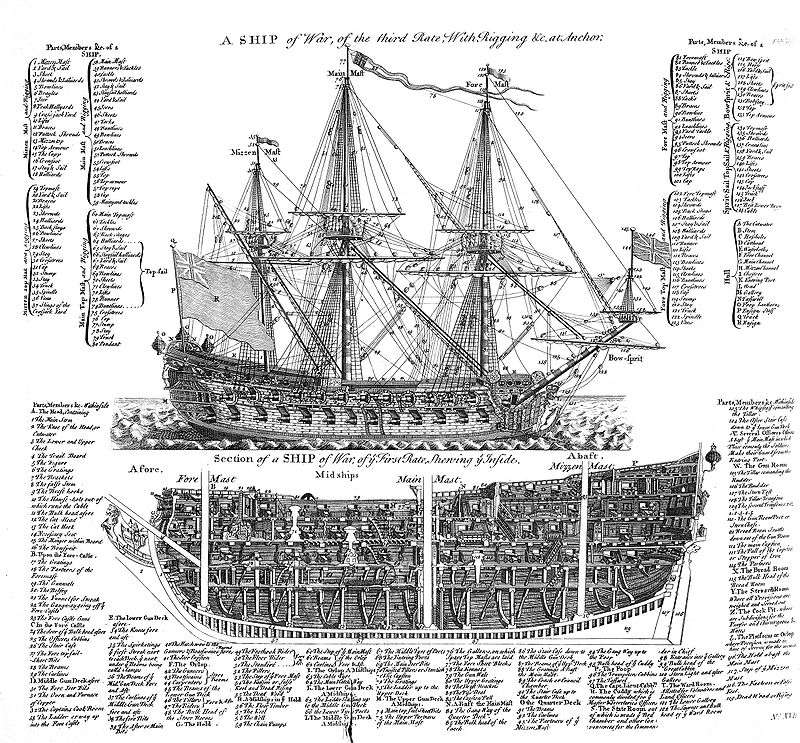HMS Lion (1709)
| History | |
|---|---|
| Name: | HMS Lion |
| Builder: | Rosewell, Chatham Dockyard |
| Launched: | 20 January 1709 |
| Fate: | Sold, 1765 |
| General characteristics as built[1] | |
| Class and type: | 1706 Establishment 60-gun fourth rate ship of the line |
| Tons burthen: | 914 bm |
| Length: | 144 ft (43.9 m) (gundeck) |
| Beam: | 38 ft (11.6 m) |
| Depth of hold: | 15 ft 8 in (4.8 m) |
| Propulsion: | Sails |
| Sail plan: | Full rigged ship |
| Armament: |
|
| General characteristics after 1738 rebuild[2] | |
| Class and type: | 1733 proposals 60-gun fourth rate ship of the line |
| Tons burthen: | 1,068 bm |
| Length: | 144 ft (43.9 m) (gundeck) |
| Beam: | 41 ft 5 in (12.6 m) |
| Depth of hold: | 16 ft 11 in (5.2 m) |
| Propulsion: | Sails |
| Sail plan: | Full rigged ship |
| Armament: |
|
HMS Lion was a 60-gun fourth rate ship of the line of the Royal Navy, built at Chatham Dockyard to the 1706 Establishment and launched on 20 January 1709.[1] Between 1710 and 1714 she was commanded by Galfridus Walpole.[3]
On 9 December 1735 orders were issued for Lion to be dismantled and rebuilt according to the 1733 proposals of the 1719 Establishment at Deptford, from where she was relaunched on 25 April 1738.

During the Jacobite rising she saw action on the 9 July 1745, when she exchanged fire with the French ships Elizabeth and the Du Teillay.[4] The Du Teillay at the time was carrying Charles Edward Stuart to Scotland with supplies and funds to support his cause. Prince Charles had boarded the French ship on 7 July at Saint-Nazaire bound for Ardmolich, they were joined by a French escort ship the ‘Elizabeth’ (L'Elisabeth). Two days later they were intercepted by the ‘Lion’, commanded by Captain Piercy Brett. A close action began at 17.00 between the ‘Lion’ and ‘Elizabeth’, with the ‘Du Teillay’ attacking the ‘Lion’ several times and, at 18.00, the ‘Lion’s’ mizzen topmast came down. By 20.00, The ‘Lion’ with her mizzen top and topmast shot away and hanging over the side was still in close action with the ‘Elizabeth’. The ‘Du Teillay’ shielded by the Elizabeth continued firing at the ‘Lion’ who returned fire with her stern guns. The ‘Lion’ continued firing at the ‘Elizabeth’ until the latter broke free at 22.00 to join the ‘Du Teillay’; by this time the ‘Lion’ was too damaged to follow; with 52 of her men were dead and about 110 wounded. The ‘Elizabeth’ had lost about 57 men with 175 wounded, her commander, Captain Dau, among the dead. On 2 August 1745, the Du Teillay landed Charles Stuart at Eriskay before returning to France.
The Lion continued in service until 1765, when she was sold out of the navy.[2]

External Links
Notes
- 1 2 Lavery, Ships of the Line vol.1, p168.
- 1 2 Lavery, Ships of the Line vol.1, p171.
- ↑ "Galfridus Walpole (d. 1726)". ThreeDecks.org. Retrieved 25 July 2014.
- ↑ http://collections.rmg.co.uk/collections/objects/11856.html National Maritime Museum
References
- Lavery, Brian (2003) The Ship of the Line - Volume 1: The development of the battlefleet 1650–1850. Conway Maritime Press. ISBN 0-85177-252-8.